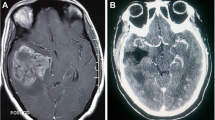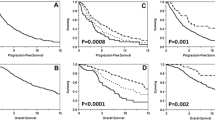Abstract
Maximal safe resection is associated with prolonged survival in patients with low-grade glioma (LGG). It has been suggested that neoadjuvant temozolomide may provide sufficient tumor shrinkage to facilitate aggressive surgical debulking. We examined the impact of temozolomide upon volume reduction and resectability of LGG. We retrospectively identified 20 adult patients with biopsy-proven, deemed not totally resectable LGGs, treated initially with temozolomide. Volumetric 3D (calculated from serial FLAIR images) and 2D tumor measurements were obtained prior to treatment and at 3 months post-treatment. The anticipated extent of resection (EOR) at the 2 time points was measured based on anatomical limitations, calculated as: [(total tumor volume – unresectable tumor volume)/total tumor volume] ×100. Eloquent cortex, deep structures and corpus callosum were considered unresectable. Mean tumor volume was 68.4 cm3 pre-treatment and 49.5 cm3 at 3 months post-treatment. The mean change from baseline to 3 months after treatment was −32.5 % (p < 0.001). Mean 2D pre-treatment area was 28.6 and 23.3 cm2 at 3 months post-treatment. The 2D change was also significant, with mean change of −17 % (p < 0.001). 5 % had partial response; 40 % minor response; 45 % stable disease; and 10 % progressive disease by RANO criteria. Mean pre-treatment anticipated EOR was 67.2 and 71.5 % at 3 months post-treatment. The mean change from baseline was 4.3 % (p = 0.10). Our findings demonstrate significant volumetric and 2D reduction of LGG with temozolomide. Although this tumor shrinkage might facilitate radical surgical resection in some cases, our data failed to show statistically significant improvement in anticipated EOR.

Similar content being viewed by others
References
Louis DN, Ohgaki H, Wiestler OD et al (2007) The 2007 WHO classification of tumours of the central nervous system. Acta Neuropathol 114:97–109
Sanai N, Chang S, Berger MS (2011) Low-grade gliomas in adults. J Neurosurg 115:948–965
Soffietti R, Baumert BG, Bello L et al (2010) Guidelines on management of low-grade gliomas: report of an EFNS-EANO Task Force. Eur J Neurol Off J Eur Fed Neurol Soc 17:1124–1133
McGirt M, Chaichana K, Attenello F et al (2008) Extent of surgical resection is independently associated with survival in patients with hemispheric infiltrating low-grade gliomas. Neurosugery 63:700–708
Shaw EG, Berkey B, Coons SW et al (2008) Recurrence following neurosurgeon-determined gross-total resection of adult supratentorial low-grade glioma: results of a prospective clinical trial. J Neurosurg 109:835–841
Smith JS, Chang EF, Lamborn KR et al (2008) Role of extent of resection in the long-term outcome of low-grade hemispheric gliomas. J Clin Oncol 26:1338–1345
Sanai N, Berger MS (2009) Operative techniques for gliomas and the value of extent of resection. Neurotherapeutics 6:478–486
Ius T, Isola M, Budai R et al (2012) Low-grade glioma surgery in eloquent areas: volumetric analysis of extent of resection and its impact on overall survival. A single-institution experience in 190 patients. J Neurosurg 117:1039–1052
Duffau H, Capelle L (2004) Preferential brain locations of low-grade gliomas. Cancer 100:2622–2626
Voloschin AD, Louis DN, Cosgrove GR, Batchelor TT (2005) Neoadjuvant temozolomide followed by complete resection of a 1p- and 19q-deleted anaplastic oligoastrocytoma: case study. Neuro-oncology 7:97–100
Duffau H, Taillandier L, Capelle L (2006) Radical surgery after chemotherapy: a new therapeutic strategy to envision in grade II glioma. J Neurooncol 80:171–176
Spena G, Garbossa D, Barletta L, Prevost C, Versari P (2010) Preoperative chemotherapy for infiltrative low-grade oligoastrocytoma: a useful strategy to maximize surgical resection -case report. Neurol Med Chir (Tokyo) 50:410–413
Blonski M, Pallud J, Goze C et al (2013) Neoadjuvant chemotherapy may optimize the extent of resection of World Health Organization grade II gliomas: a case series of 17 patients. J Neurooncol 113:267–275
Blonski M, Taillandier L, Herbet G, Maldonado I, Beauschesne P, Fabbro M (2012) Combination of neoadjuvant chemotherapy followed by surgical resection as a new strategy for WHO grade II gliomas: a study of cognitive status and quality of life. J Neurooncol 106:353–366
van den Bent MJ, Wefel JS, Schiff D et al (2011) Response assessment in neuro-oncology (a report of the RANO group): assessment of outcome in trials of diffuse low-grade gliomas. Lancet Oncol 12:583–593
Prabhu VC, Khaldi A, Barton KP et al (2010) Management of diffuse low-grade cerebral gliomas. Neurol Clin 28:1037–1059
Skrap M, Mondani M, Tomasino B et al (2012) Surgery of insular nonenhancing gliomas: volumetric analysis of tumoral resection, clinical outcome, and survival in a consecutive series of 66 cases. Neurosurgery 70:1081–1093 discussion 1093–1084
Bauman G, Pahapill P, Macdonald D, Fisher B, Leighton C, Cairncross G (1999) Low grade glioma: a measuring radiographic response to radiotherapy. Can J Neurol Sci Le journal canadien des sciences neurologiques 26:18–22
Pallud J, Llitjos JF, Dhermain F et al (2012) Dynamic imaging response following radiation therapy predicts long-term outcomes for diffuse low-grade gliomas. Neuro-oncology 14:496–505
van den Bent M, Afra D, de Witte O (2005) Ben Hassel M. Long-term efficacy of early versus delayed radiotherapy for low-grade astrocytoma and oligodendroglioma in adults: the EORTC 22845 randomised trial. Lancet 366:985–990
Douw L, Klein M, Fagel SS et al (2009) Cognitive and radiological effects of radiotherapy in patients with low-grade glioma: long-term follow-up. Lancet Neurol 8:810–818
Kaloshi G, Benouaich-Amiel A, Diakite F et al (2007) Temozolomide for low-grade gliomas: predictive impact of 1p/19q loss on response and outcome. Neurology 68:1831–1836
Hoang-Xuan K, Capelle L, Kujas M et al (2004) Temozolomide as initial treatment for adults with low-grade oligodendrogliomas or oligoastrocytomas and correlation with chromosome 1p deletions. J Clin Oncol 22:3133–3138
Tosoni A, Franceschi E, Ermani M et al (2008) Temozolomide three weeks on and one week off as first line therapy for patients with recurrent or progressive low grade gliomas. J Neurooncol 89:179–185
Brada M, Viviers L, Abson C et al (2003) Phase II study of primary temozolomide chemotherapy in patients with WHO grade II gliomas. Ann Oncol 14:1715–1721
Viacoz A, Lekoubou A, Ducray F (2012) Chemotherapy in low-grade gliomas. Curr Opin Oncol 24:694–701
Baumert BG, Mason W, Ryan G et al (2013) Temozolomide chemotherapy versus radiotherapy in molecularly characterized (1p loss) low-grade glioma: a randomized phase III intergroup study by the EORTC/NCIC-CTG/TROG/MRC-CTU (EORTC 22033–26033). J Clin Oncol 31 (suppl; abstr 2007)
Jakola AS, Myrmel KS, Kloster R et al (2012) Comparison of a strategy favoring early surgical resection vs a strategy favoring watchful waiting in low-grade gliomas. JAMA 308:1881–1888
Schiff D (2007) Temozolomide and radiation in low-grade and anaplastic gliomas: temoradiation. Cancer Invest 25:776–784
Cairncross JG, Wang M, Jenkins RB et al (2014) Benefit from procarbazine, lomustine, and vincristine in oligodendroglial tumors is associated with mutation of IDH. J Clin Oncol 32(8):783–790
Bourne T, Schiff D (2010) Update on molecular findings, management and outcome in low-grade glioma. Nat Rev Neurol 6:695–701
Lai A, Kharbanda S, Pope WB et al (2011) Evidence for sequenced molecular evolution of IDH1 mutant glioblastoma from a distinct cell of origin. J Clin Oncol 29:4482–4490
Hegi ME, Diserens AC, Gorlia T et al (2005) MGMT gene silencing and benefit from temozolomide in glioblastoma. N Engl J Med 352:997–1003
Dempsey MF, Condon BR, Hadley DM (2005) Measurement of tumor “size” in recurrent malignant glioma: 1D, 2D, or 3D? AJNR Am J Neuroradiol 26:770–776
Mandonnet E, Pallud J, Clatz O et al (2008) Computational modeling of the WHO grade II glioma dynamics: principles and applications to management paradigm. Neurosurg Rev 31:263–269
Caseiras GB, Ciccareli O, Altmann DR, Benton CE (2009) Low-grade gliomas: six-month tumor growth predicts patient outcome better than admission tumor volume, relative cerebral blood volume, and apparent diffusion coefficient. Radiology 253:505–512
Lubrano V, Draper L, Roux FE (2010) What makes surgical tumor resection feasible in Broca’s area? insights into intraoperative brain mapping. Neurosurgery 66:868–875
Sarubbo S, Latini F, Sette E et al (2012) Is the resection of gliomas in Wernicke’s area reliable?: Wernicke’s area resection. Acta Neurochir 154:1653–1662
Sanai N, Polley MY, Berger MS (2010) Insular glioma resection: assessment of patient morbidity, survival, and tumor progression. J Neurosurg 112:1–9
Duffau H (2012) The challenge to remove diffuse low-grade gliomas while preserving brain functions. Acta Neurochir (Wien) 154:569–574
Chang EF, Clark A, Smith JS et al (2011) Functional mapping-guided resection of low-grade gliomas in eloquent areas of the brain: improvement of long-term survival. Clinical article. J Neurosurg 114:566–573
Duffau H, Khalil I, Gatignol P, Denvil D, Capelle L (2004) Surgical removal of corpus callosum infiltrated by low-grade glioma: functional outcome and oncological considerations. J Neurosurg 100:431–437
Conflict of interest
The authors declare they have no conflict of interest.
Author information
Authors and Affiliations
Corresponding author
Rights and permissions
About this article
Cite this article
Jo, J., Williams, B., Smolkin, M. et al. Effect of neoadjuvant temozolomide upon volume reduction and resection of diffuse low-grade glioma. J Neurooncol 120, 155–161 (2014). https://doi.org/10.1007/s11060-014-1538-7
Received:
Accepted:
Published:
Issue Date:
DOI: https://doi.org/10.1007/s11060-014-1538-7




